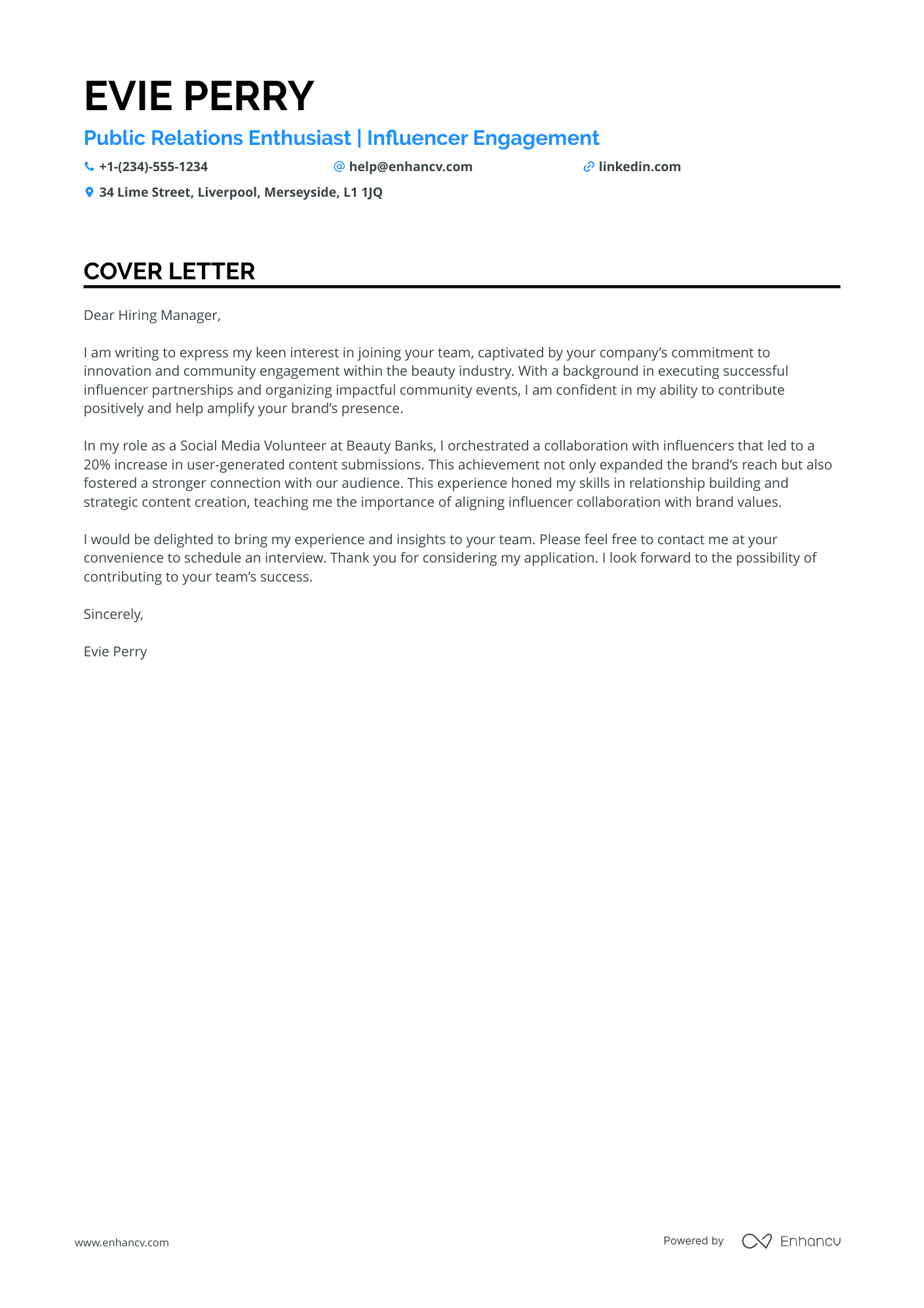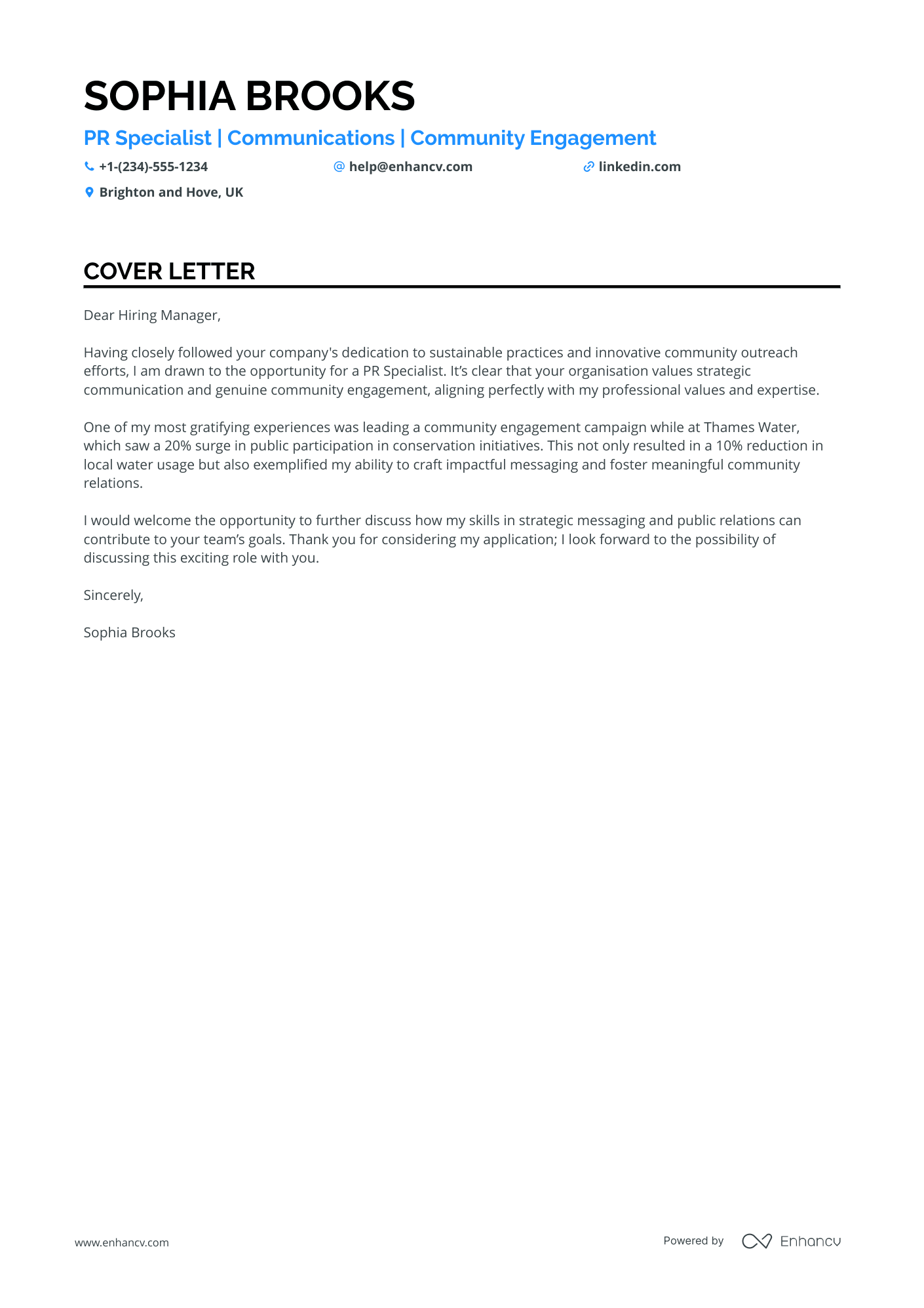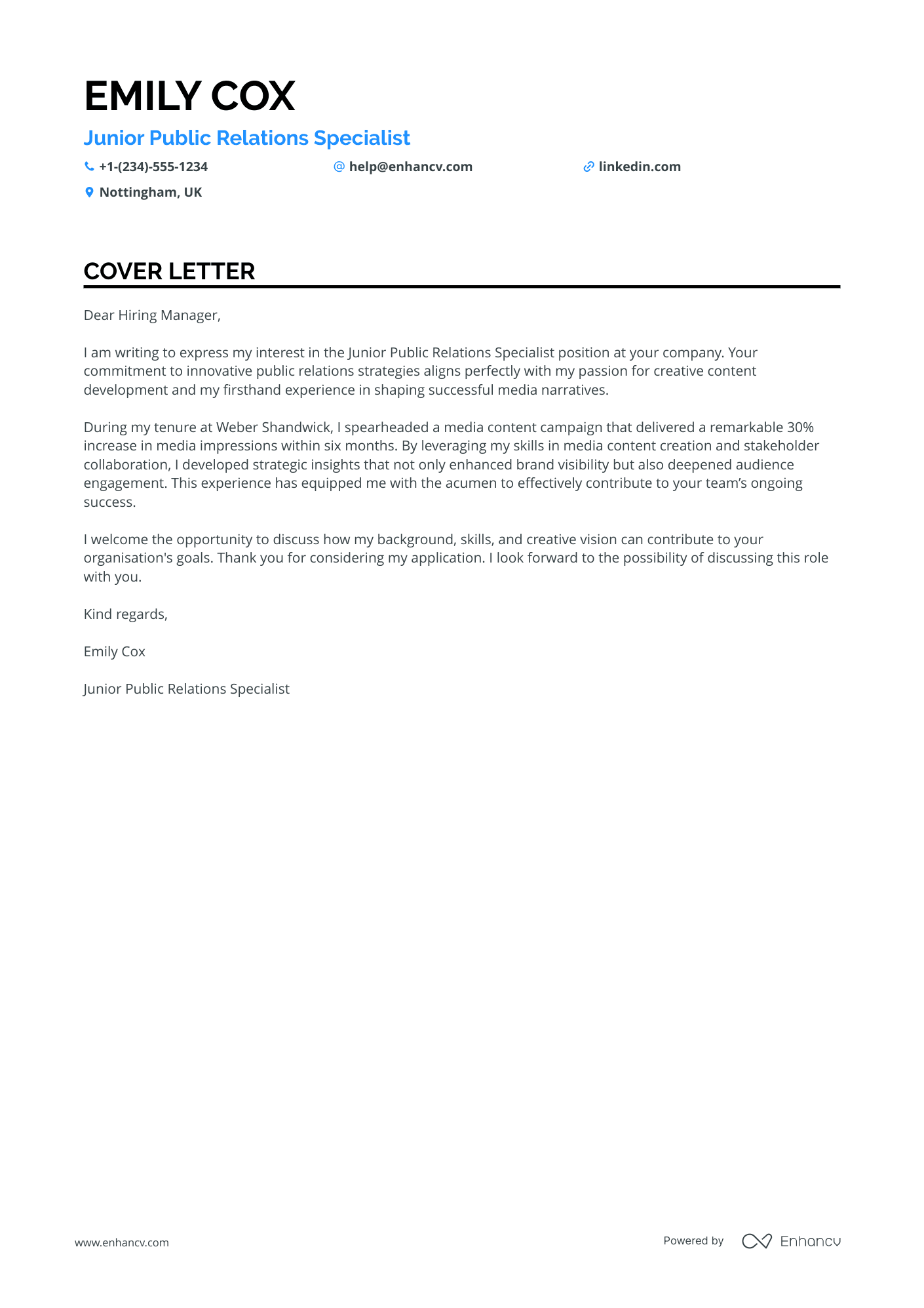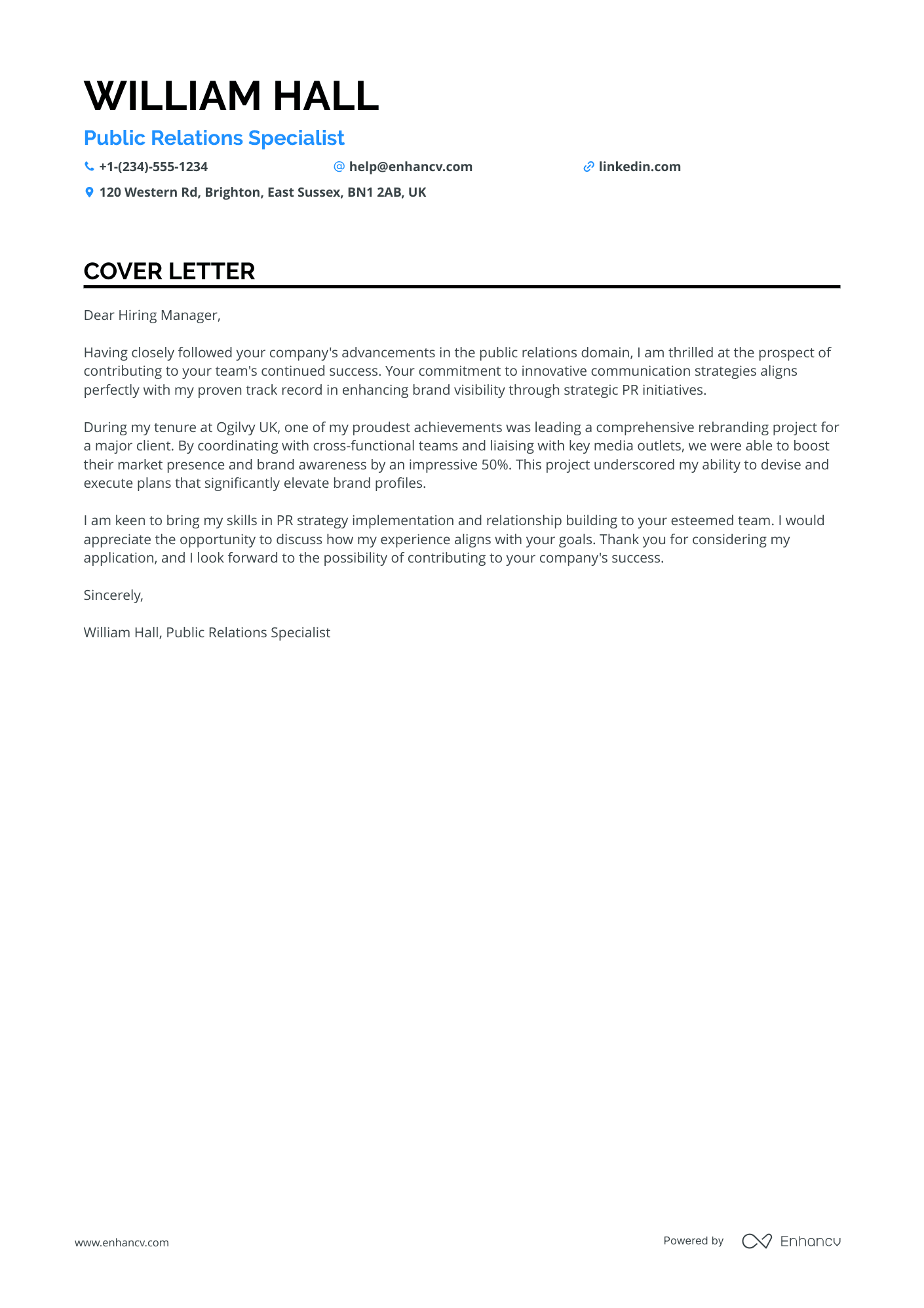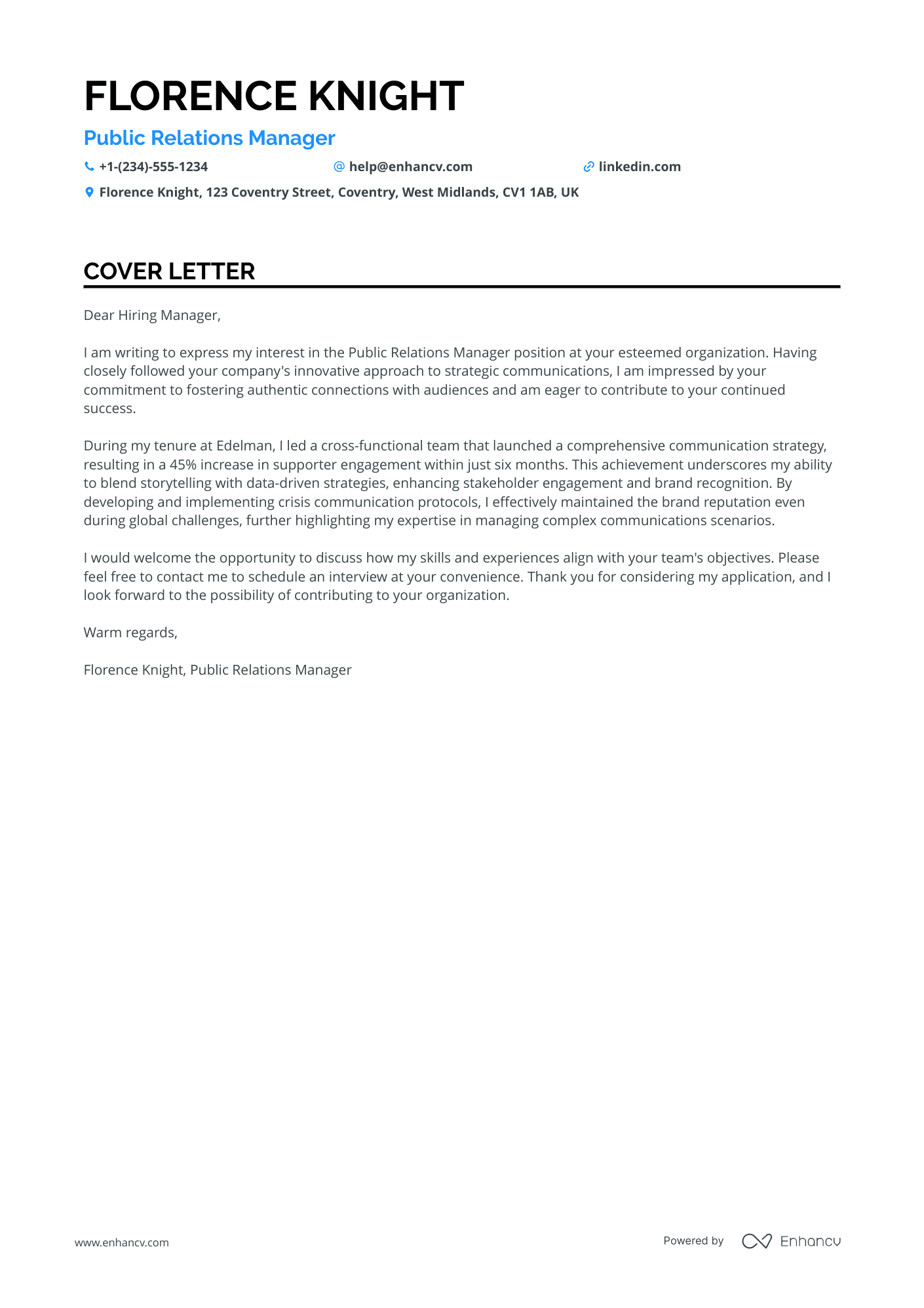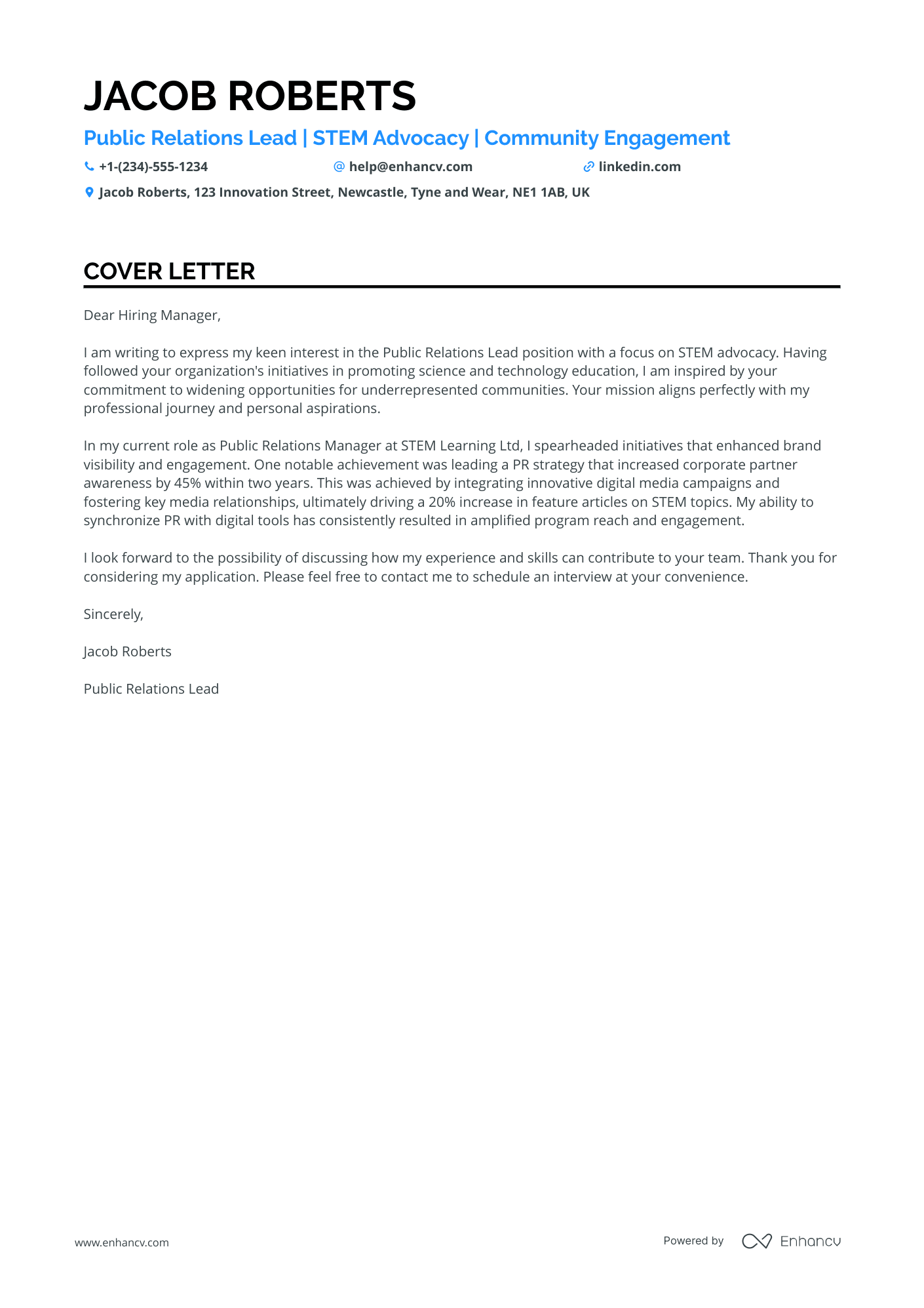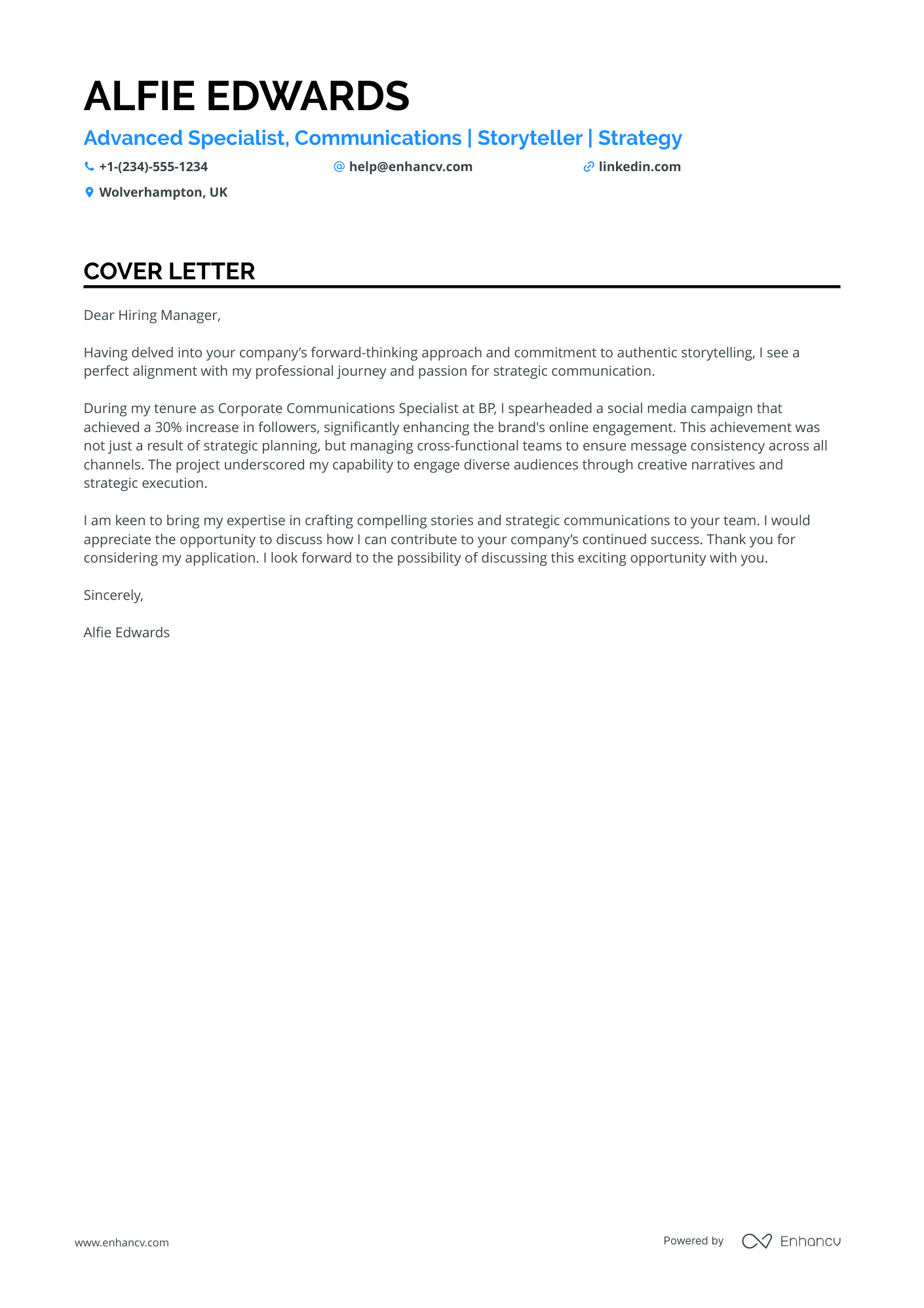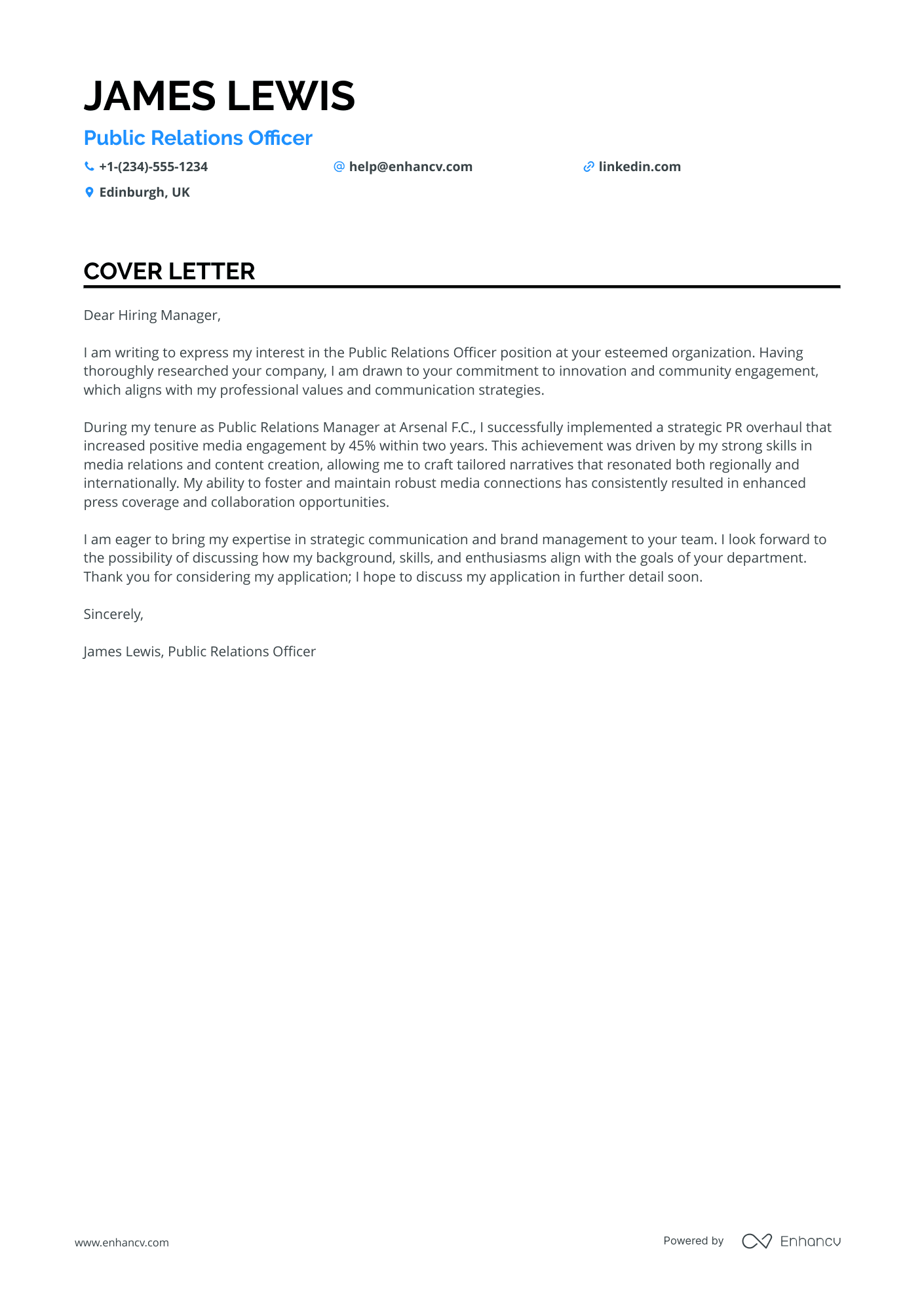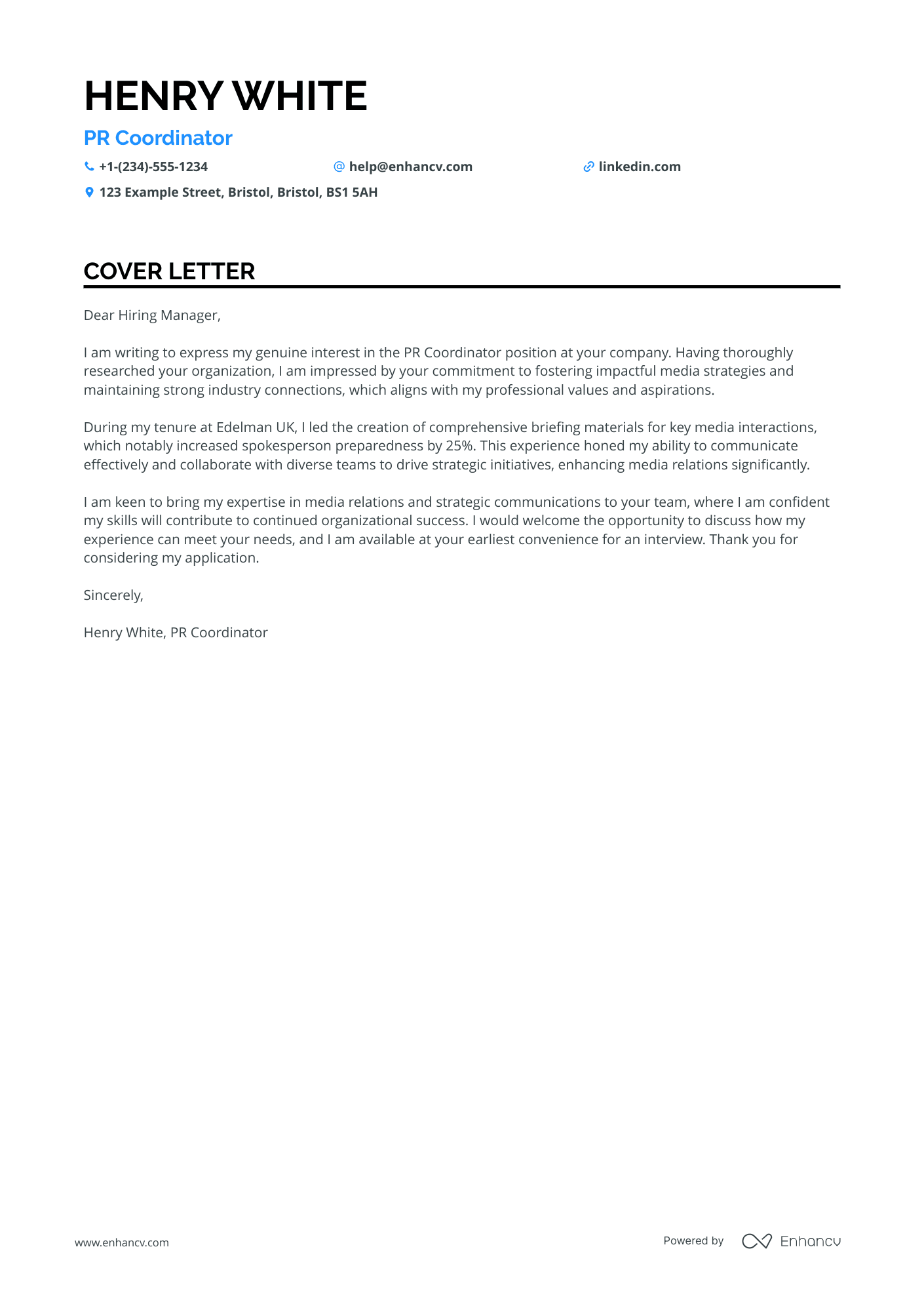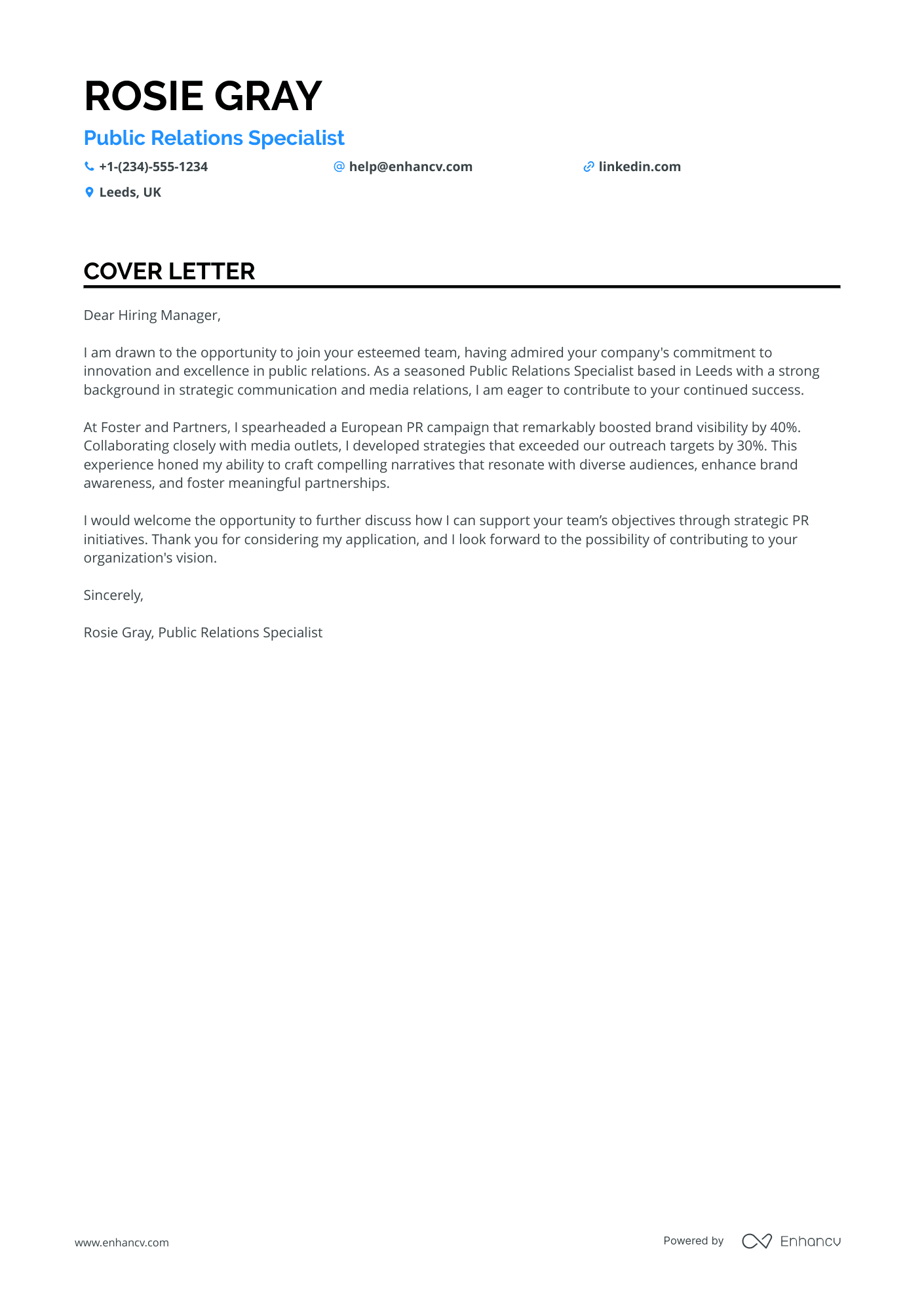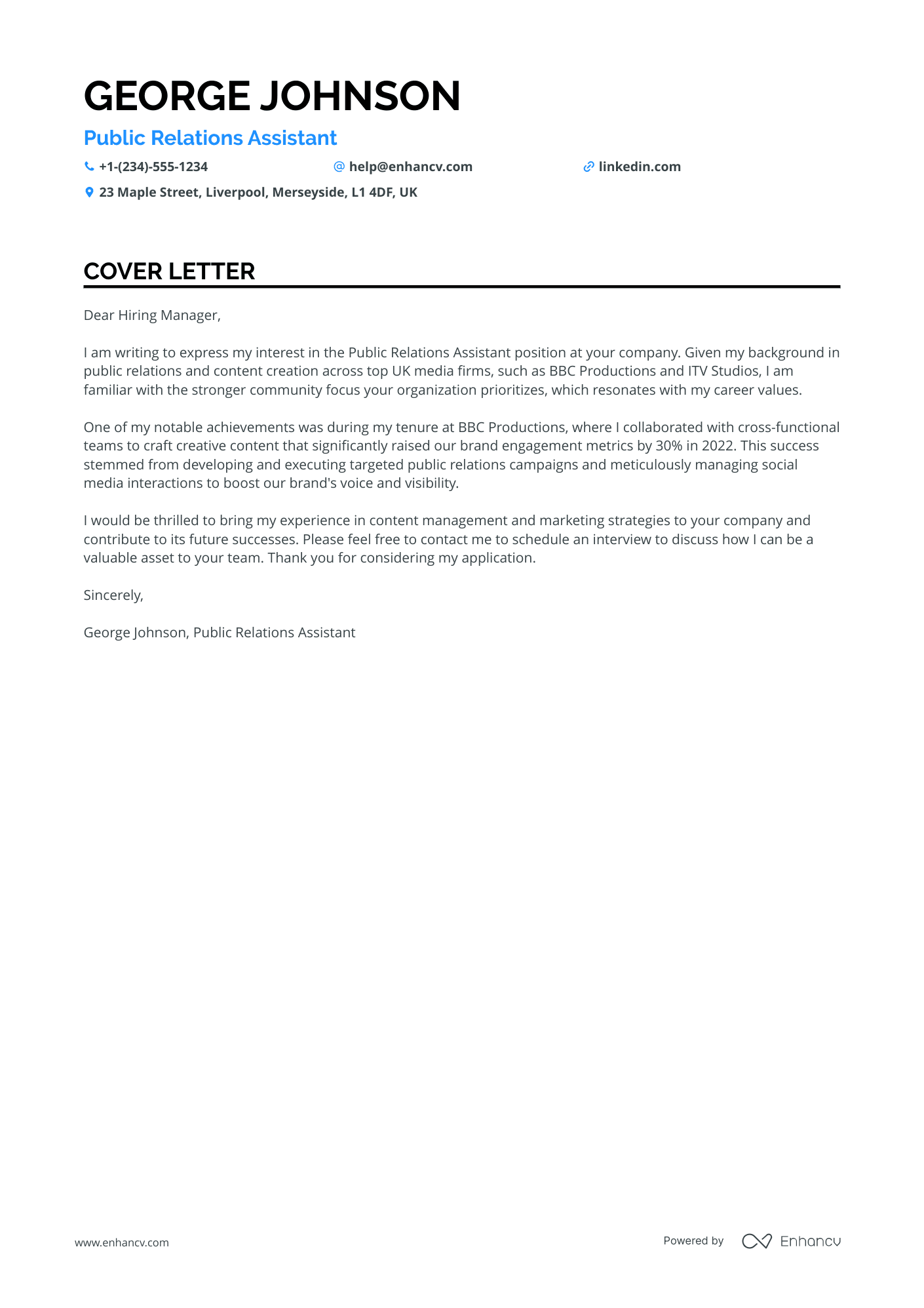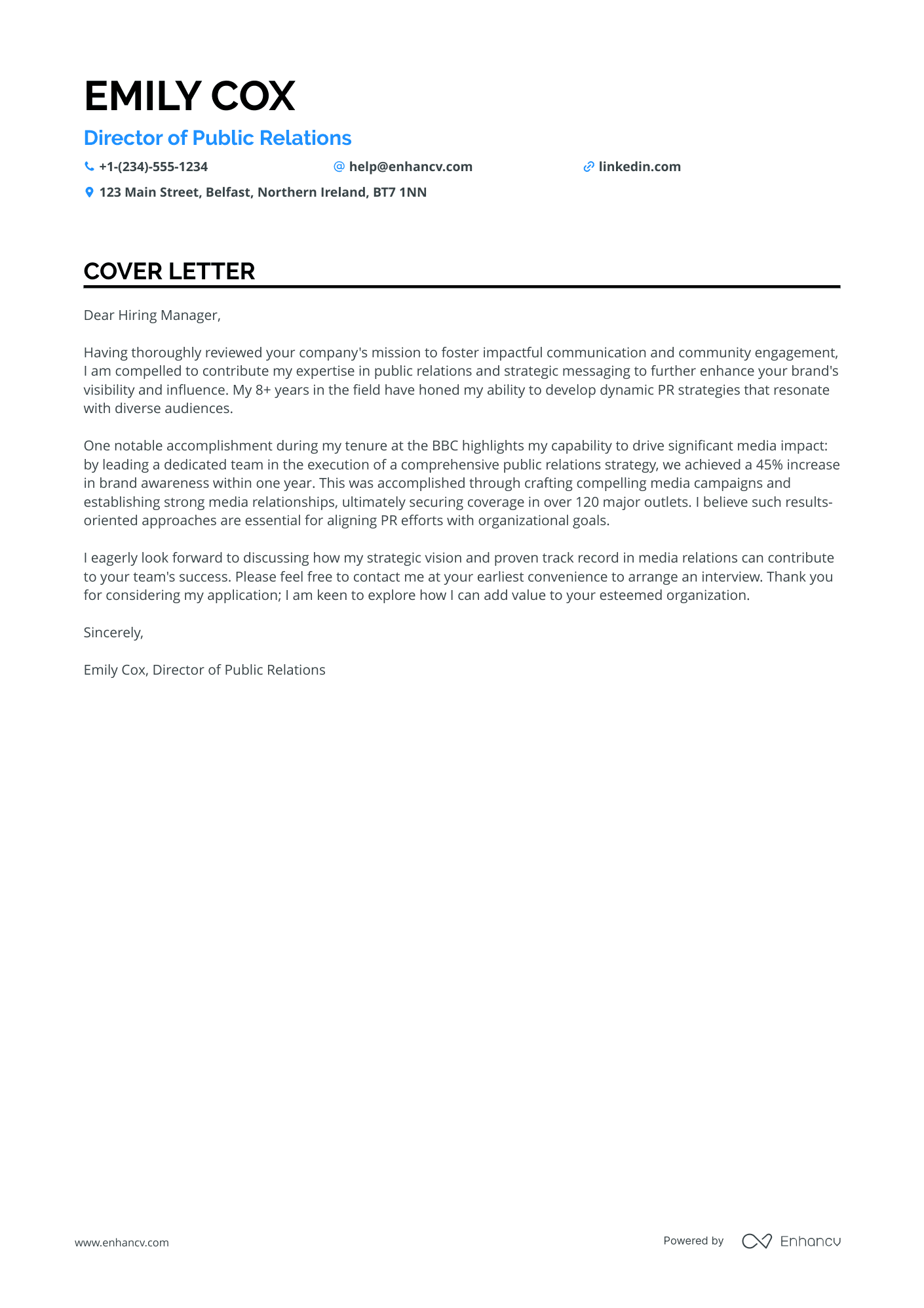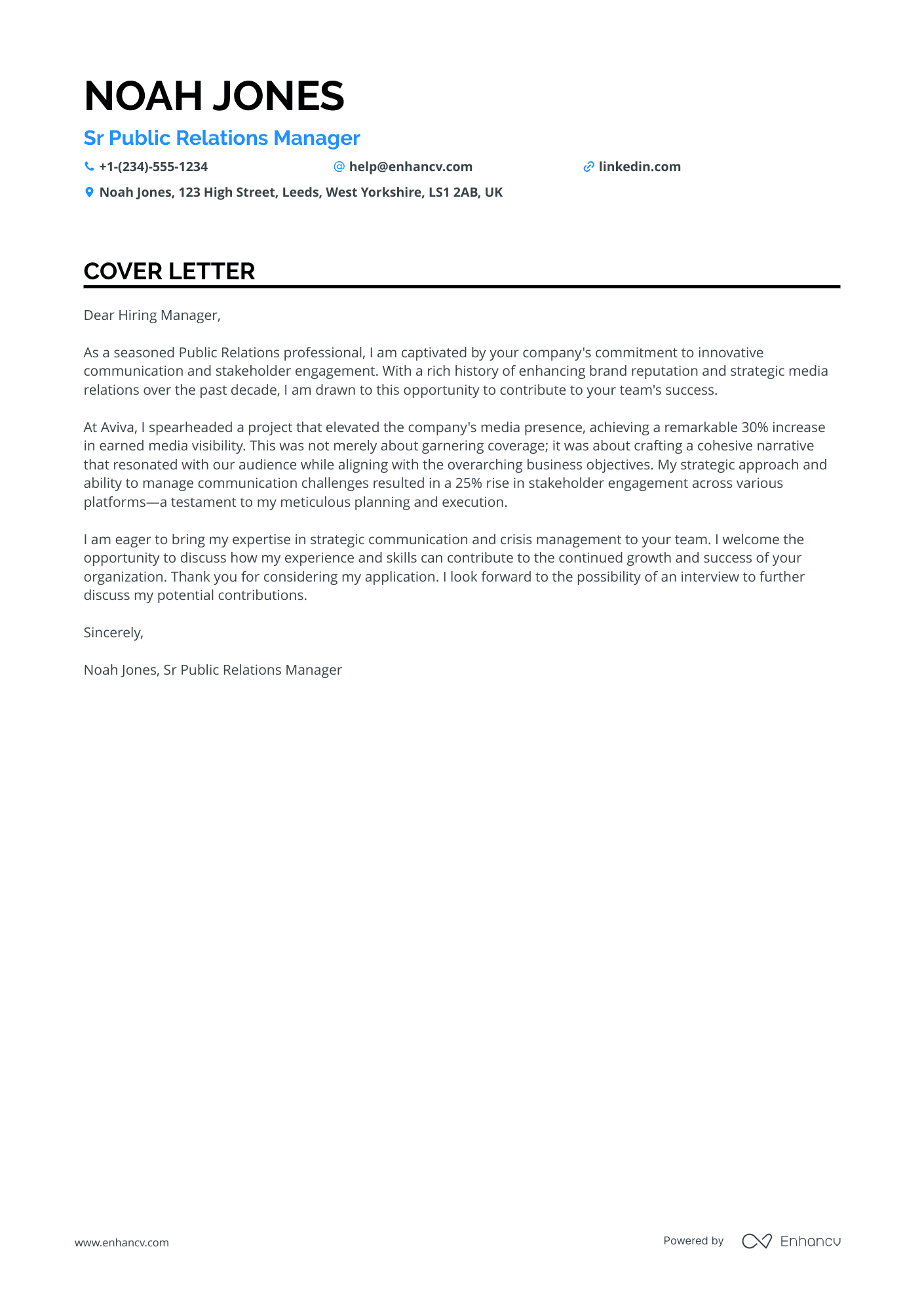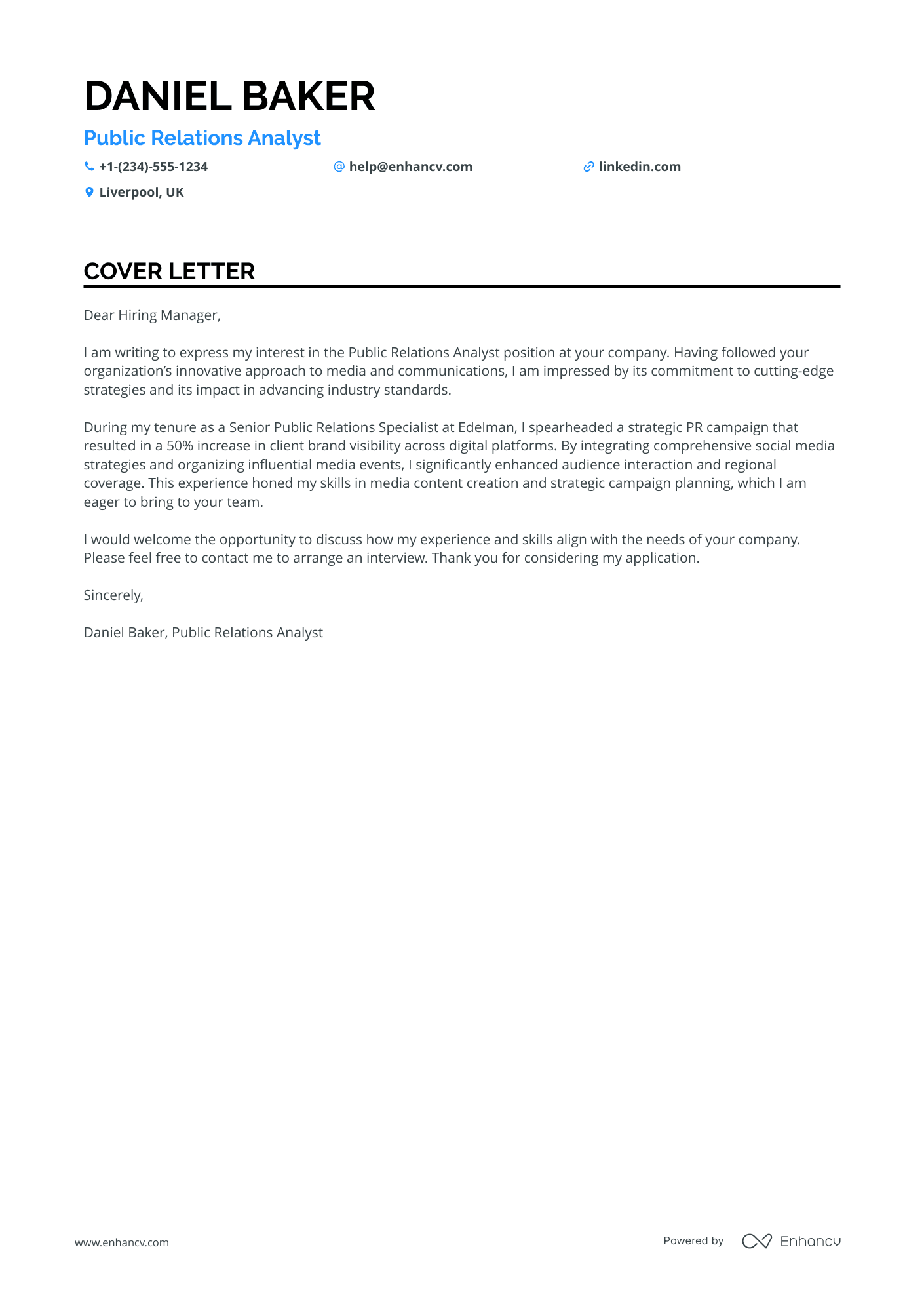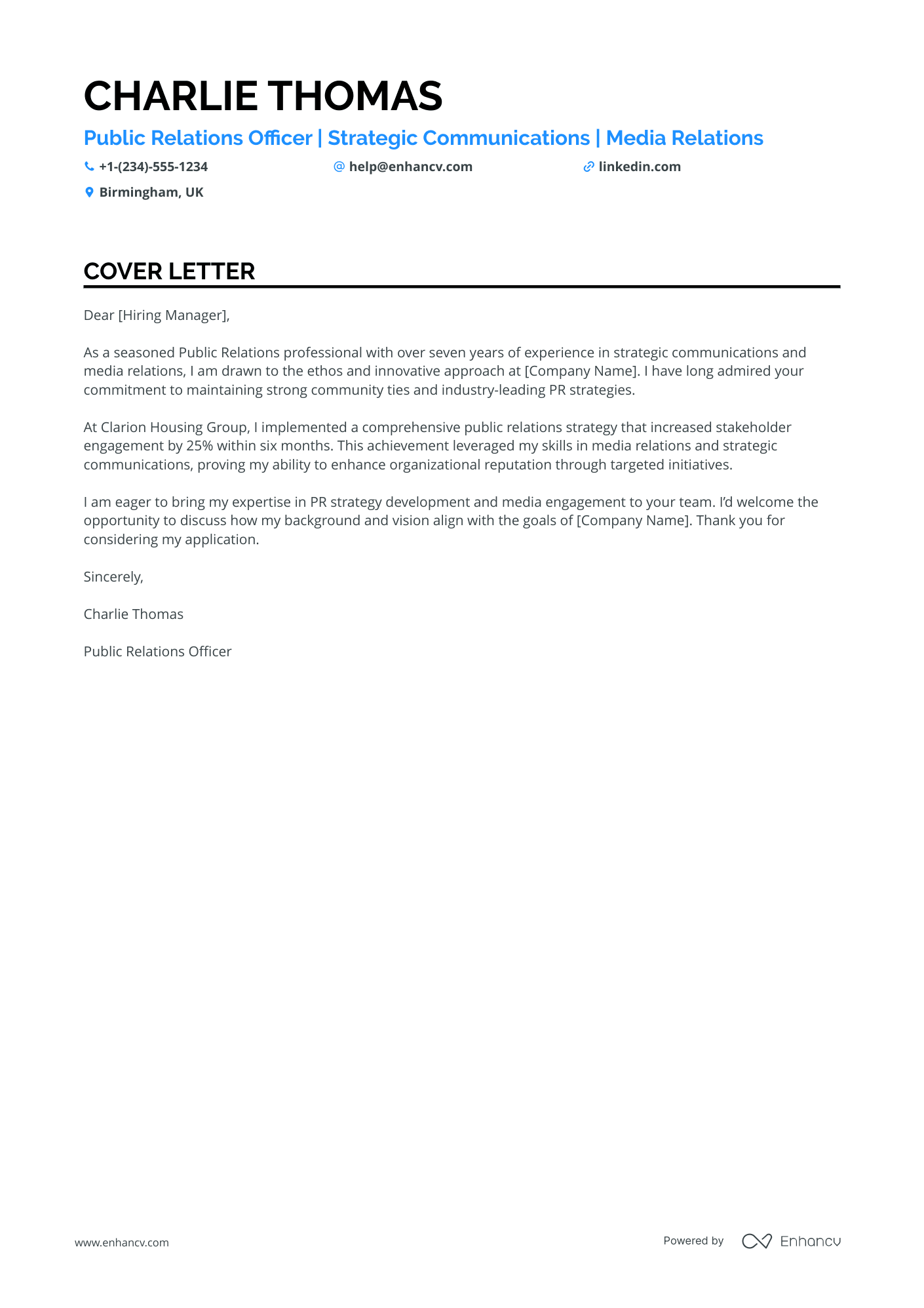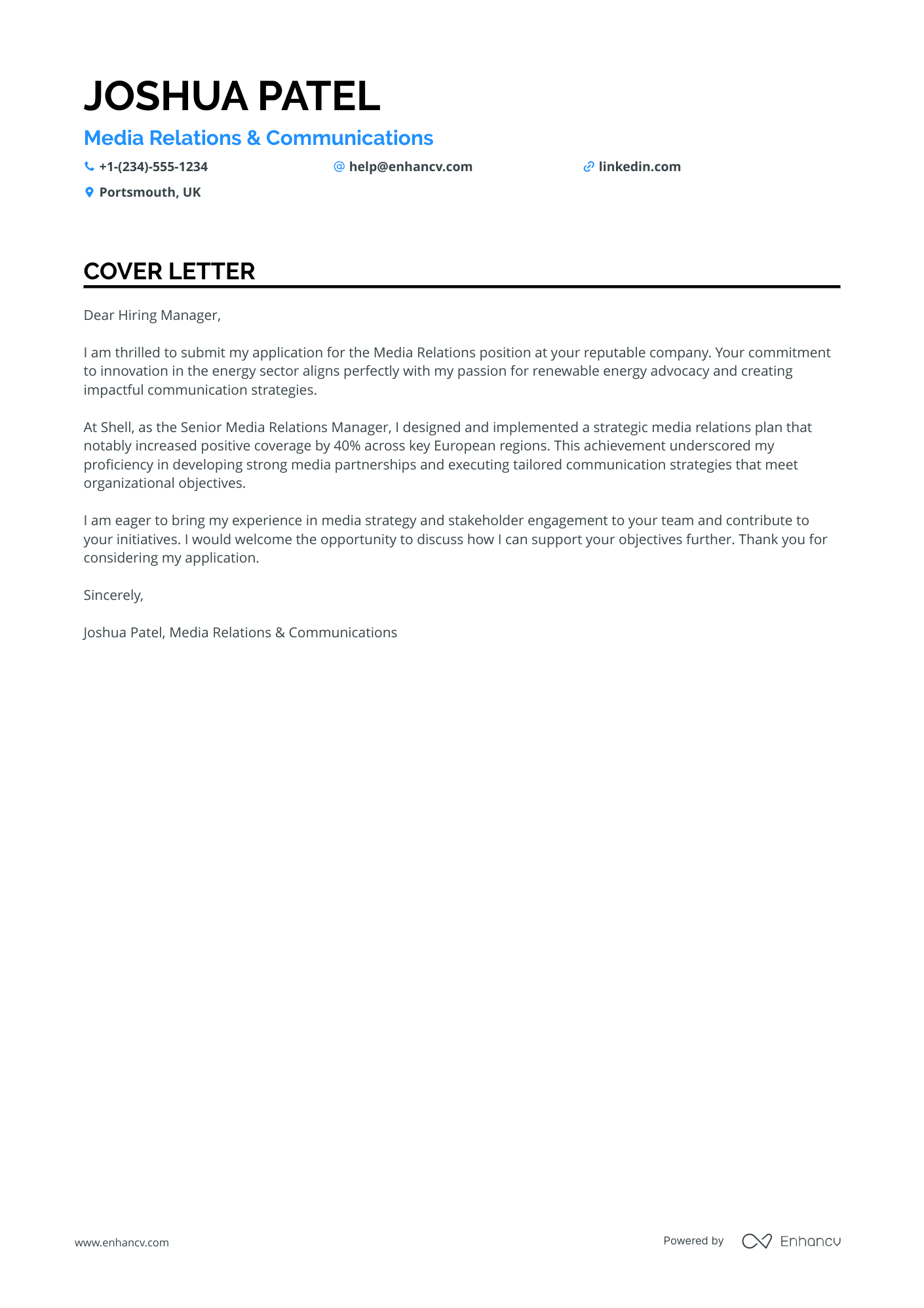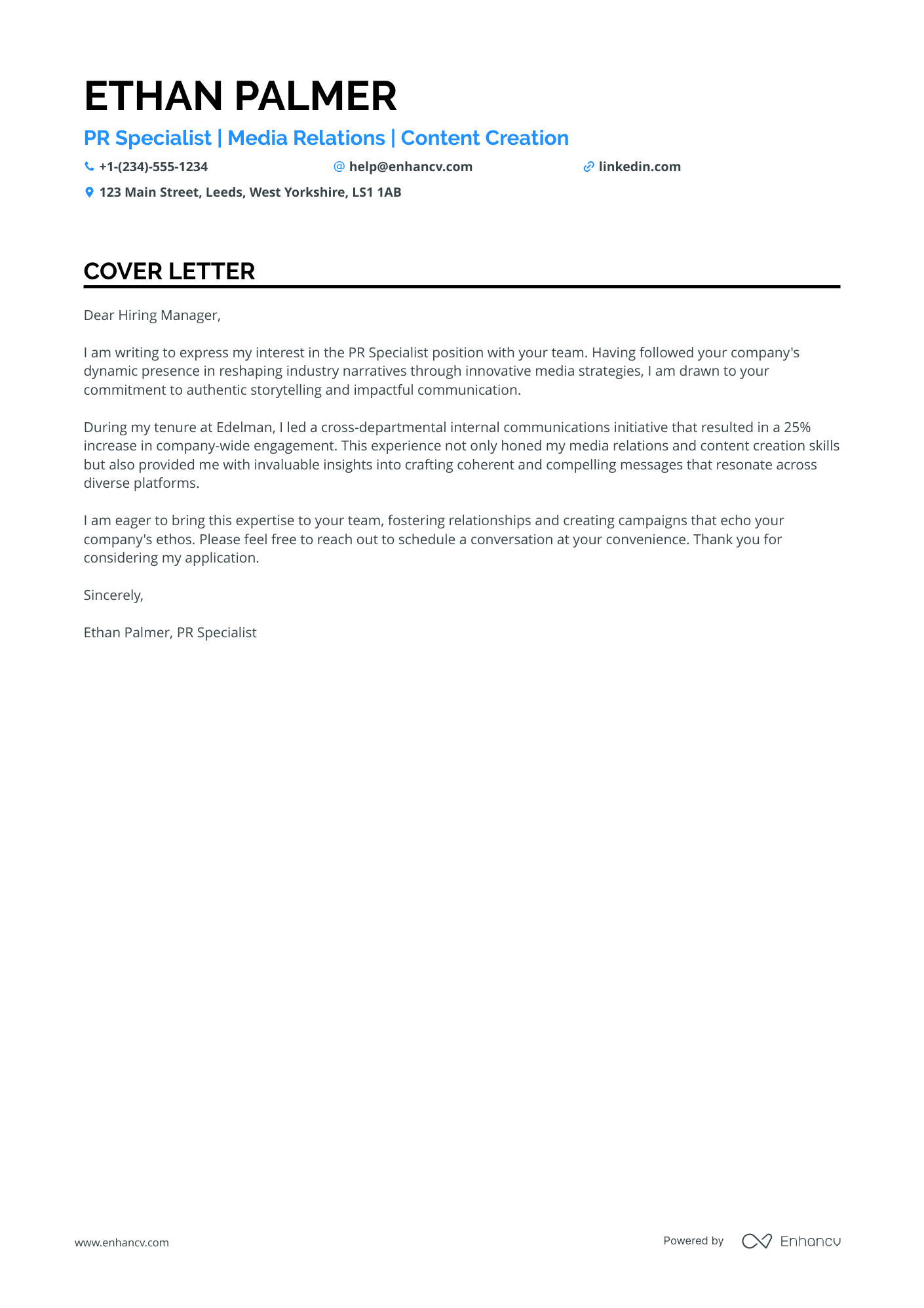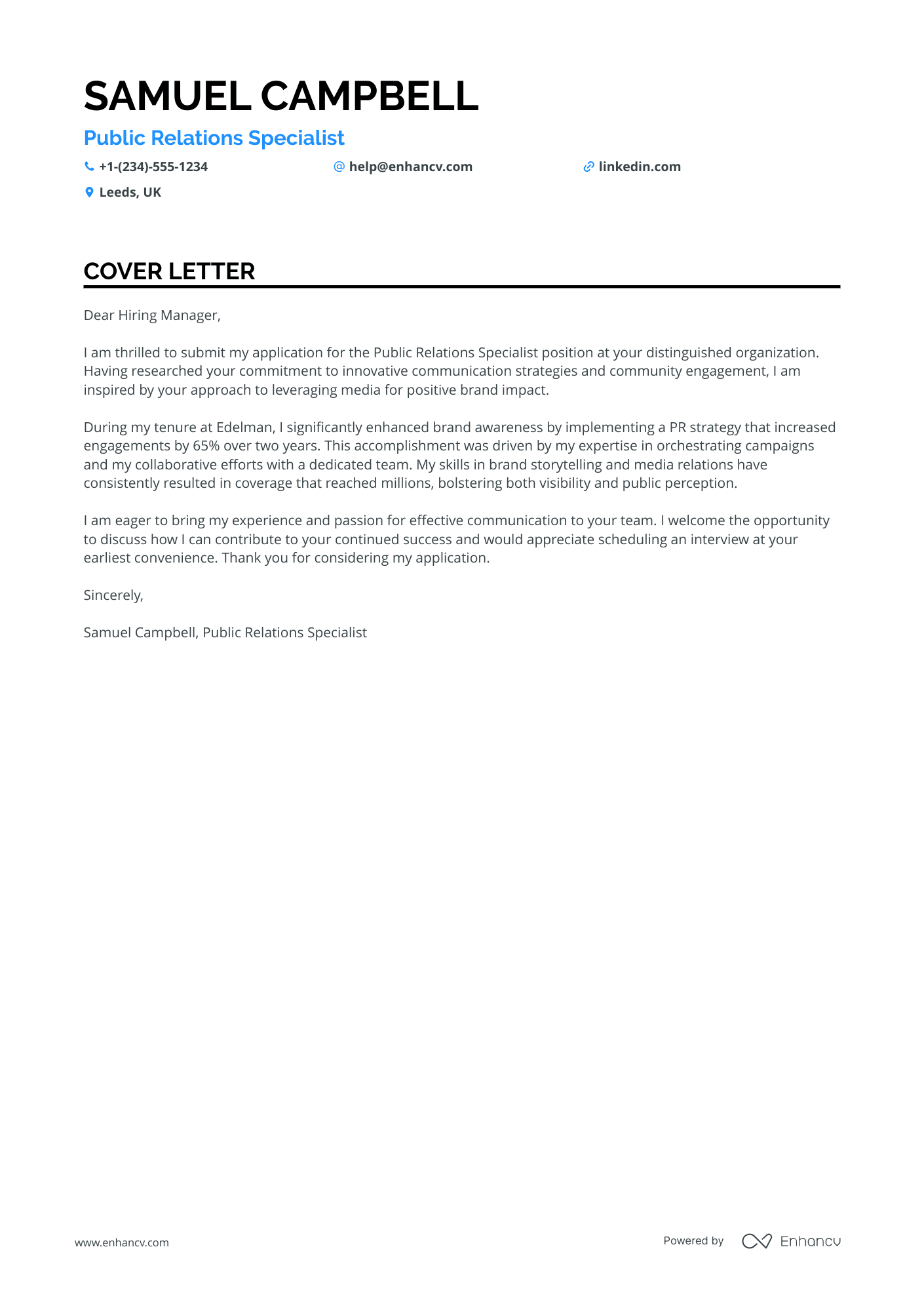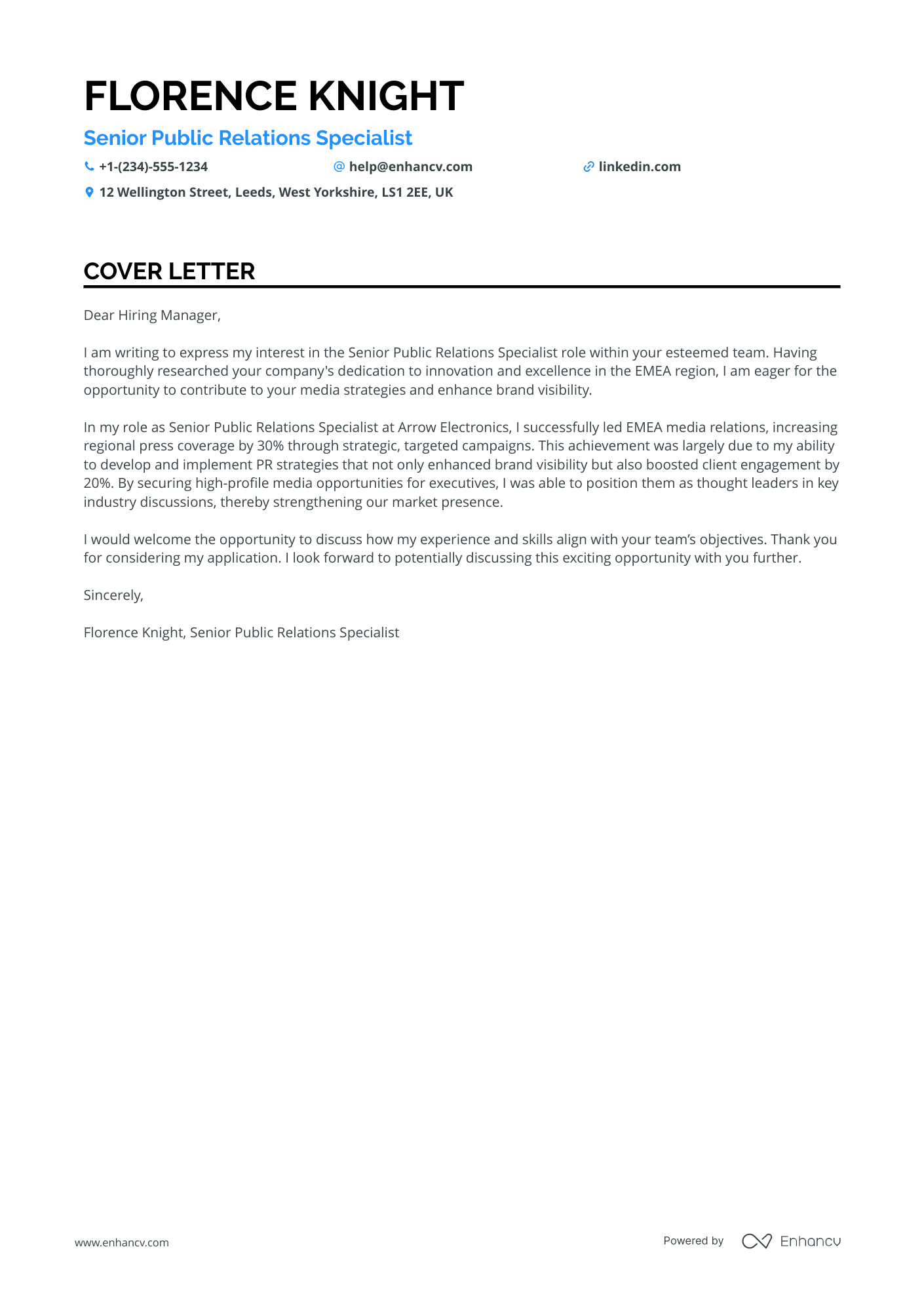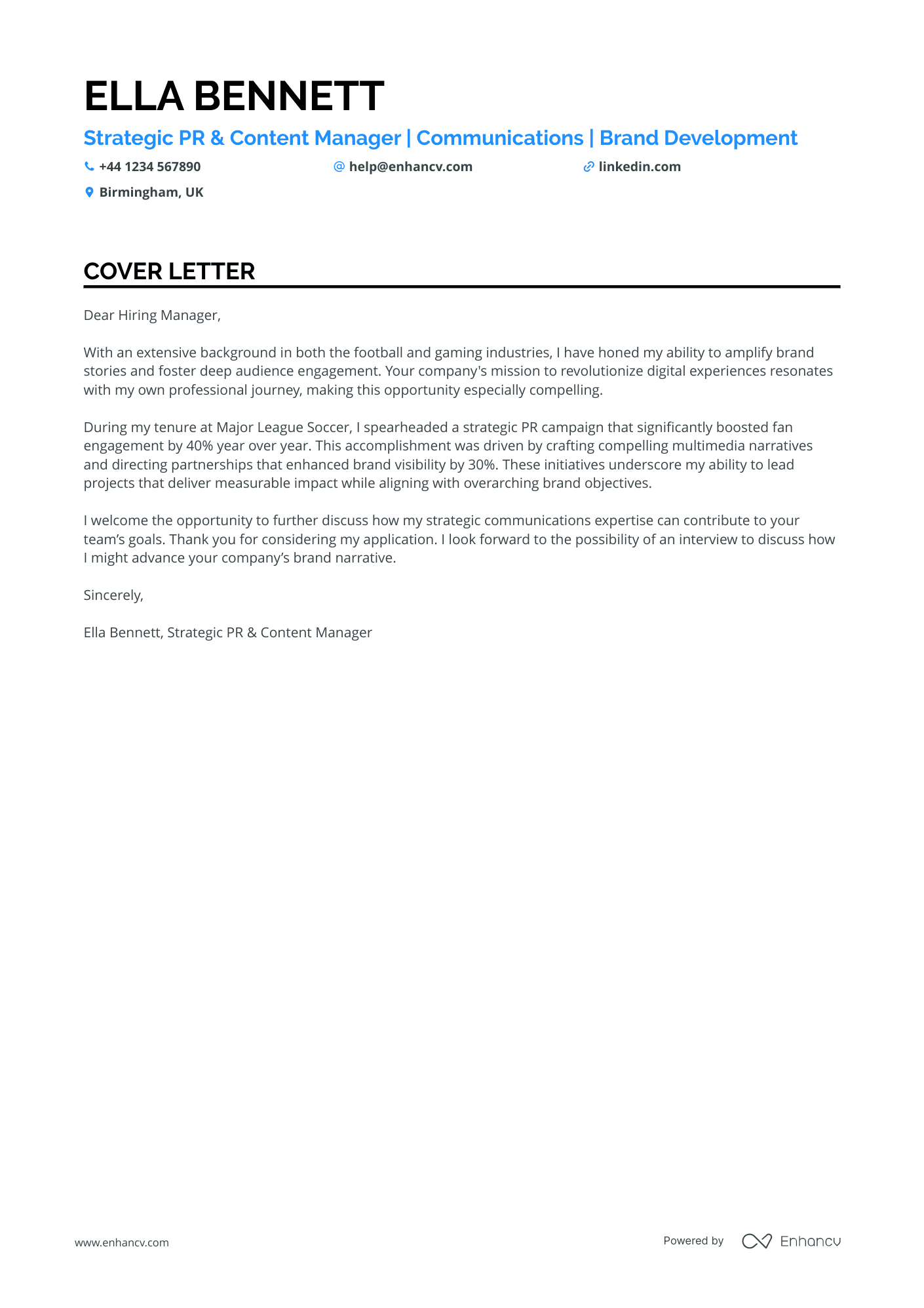Congratulations on completing your first cover letter. However, as you look back, you realise it’s simply a copy-paste of your CV.
Repeating your curriculum vitae is a common pitfall that many candidates encounter, making the cover letter redundant.
Your cover letter should provide fresh insights, adding more value to your application. It’s also the ideal space to address career gaps or major transitions that might not be covered in your CV.
In this guide, you’ll learn how to use your cover letter to demonstrate why you’re the best candidate for the role, while confidently addressing your career history and key achievements.
Cover letter examples for public relations
By Experience
Public Relations Intern
- Relevant Experience: The cover letter effectively highlights the applicant's hands-on experience in social media management and influencer collaborations, which are crucial for a Public Relations role focused on influencer engagement.
- Educational Background: The mention of pursuing a Bachelor of Arts in Public Relations aligns well with career goals, establishing the candidate as committed and knowledgeable in the field.
- Skills and Achievements: Pointing out specific skills such as networking and event coordination, along with achievements in boosting social engagement, demonstrates a proven track record of success in relevant areas.
- Passion and Volunteering: Showcasing volunteering roles and personal passions, such as digital content creation and beauty industry trends, adds depth to the applicant's profile, illustrating a genuine interest in the sector.
Senior Public Relations Specialist
- Strategic Highlight: Emphasise the Advanced PR Strategies certification from the Chartered Institute of Public Relations, showcasing expertise in strategic planning and multimedia content development that align with the role’s requirements.
- Skill Emphasis: Detail proficiency in Crisis Communication Management, highlighting capability to manage communication effectively during crises, a critical aspect for water districts handling public relations amidst potential infrastructure incidents.
- Experience Showcase: Outline successful community engagement initiatives previously led, illustrating ability to enhance public participation and foster relationships with local partners, supporting the organisational goals of community-focused public relations.
- Passion Alignment: Connect personal passion for Water Conservation with professional roles, demonstrating a genuine commitment to the industry and adding depth to application appeal.
Junior Public Relations Officer
- Quantified Achievements: The cover letter effectively quantifies achievements, such as increasing media impressions by 30% and social media followers by 25%, demonstrating Emily's impact in prior roles.
- Relevant Experience: Experience as a Public Relations Assistant and PR Intern at notable firms like Weber Shandwick and Edelman provides substantial industry-specific background, enhancing her candidature.
- Relevant Skills: Emphasising skills in Media Content Creation, Public Relations, and Social Media Management aligns closely with the job requirements for a Junior Public Relations Specialist.
- Professional Development: Completion of relevant courses such as "Digital Media and Public Relations" and "Content Marketing Certification" highlights Emily's commitment to continuous learning in her field.
Entry-Level Public Relations Assistant
- Emphasising extensive experience with measurable outcomes in PR strategy implementation, such as increasing client visibility by 45% within a specified timeframe, showcases a results-driven approach that is crucial for public relations roles.
- Highlighting specific skills like event coordination and relationship building, supported by examples of coordinating over 25 successful events and establishing key media relationships, aligns well with the responsibilities of a Public Relations Specialist.
- Mentioning a targeted educational background and relevant courses, such as the Associate of Arts in Communications and a certification in Public Relations Media Strategy, provides credibility and demonstrates a commitment to the field.
- Showcasing achievements in crisis management and successful campaigns, such as a rebranding project boosting market presence by 50%, underscores the candidate's ability to handle challenges and drive substantial brand impact.
Experienced Public Relations Manager
- Highlighting Impactful Results: Florence effectively uses quantitative data to demonstrate achievements, such as increasing engagement by 45% and improving web traffic by 52%, which showcases their results-driven approach and success in the field.
- Diverse Experience: The cover letter thoroughly details Florence's extensive experience across reputable companies in the UK, illustrating their ability to work in various industries and contexts, enhancing their credibility as a Public Relations Manager.
- Emphasis on Crisis Communications: Florence highlights her experience in developing crisis communication protocols, an essential skill for a Public Relations Manager, effectively showcasing their preparedness to handle challenging situations while maintaining brand reputation.
- Alignment with Business Goals: Florence's experience in crafting narratives that align with business objectives demonstrates a strategic mindset essential for aligning communication efforts with organisational goals, underscoring their capability in strategic communications.
Lead Public Relations Director
- Emphasising STEM Advocacy: The cover letter effectively highlights Jacob's commitment to enhancing STEM education for underserved communities, which is essential for a Public Relations Lead specialising in STEM advocacy.
- Showcasing Relevant Experience: The letter details over five years of experience in public relations, listing significant achievements like spearheading virtual STEM events and increasing social media engagement, aligning well with the role's focus areas.
- Highlighting Leadership Skills: Jacob's leadership in managing teams and developing PR strategies is showcased through concrete examples, such as leading a team to implement strategies that increased awareness by 45%.
- Demonstrating Continuous Learning: By mentioning specific courses like "Digital PR and Marketing Strategies" and "Advanced Media Relations," the letter underlines Jacob's commitment to staying updated with current trends and tools in the field.
Advanced Public Relations Analyst
- Alfie effectively highlights his strategic achievements in enhancing brand awareness, such as boosting BP's brand visibility by 25% in just one year, which showcases results-driven impact crucial for roles in communications.
- The cover letter includes specific metrics that quantify success, like the 30% increase in social media followers, to provide concrete examples of Alfie's capabilities in digital media engagement and strategy execution.
- By mentioning educational credentials, including a BA in Communications and an MSc in Public Relations, Alfie assuredly demonstrates a solid academic foundation that substantiates his professional expertise in the communications field.
- Emphasising proficiency in crisis management and stakeholder engagement directly aligns with the responsibilities of an Advanced Specialist in Communications, ensuring Alfie's skills are relevant to strategic organisational success.
Chief Public Relations Officer
- Evidence of Impact: Highlighting a substantial 45% increase in media coverage through strategic PR management shows quantifiable results, which is crucial in public relations roles.
- Crisis Management Expertise: Detailing successful crisis communications and the ability to maintain brand reputation under pressure is vital for prospective employers in PR fields.
- Professional Credentials: Including specialised courses, such as the Advanced Crisis Communication Strategies and Digital PR Mastery, showcases further commitment and expertise in the sector.
- Media Relations Success: Demonstrating the growth of media contacts and coverage, supported by figures (e.g., 30% increase), reinforces the candidate’s networking and communication skills.
By Role
Public Relations Coordinator
- Relevant Experience: Emphasises over three years of experience in PR and media relations, critical for a PR Coordinator role. This background establishes credibility in managing media communications and strategic initiatives.
- Key Achievements: Highlights significant accomplishments like driving media coverage growth by 30% and enhancing spokesperson preparedness by 25%. Quantifying achievements demonstrates tangible impact and value.
- Specific Skills: Showcases essential skills such as media relations, strategic communications, and media monitoring tools, aligning perfectly with the core responsibilities of the PR Coordinator position.
- Education Credentials: Includes advanced education in Public Relations and Journalism, underpinning the candidate's knowledge and expertise essential for professional communication roles.
Public Relations Specialist
- Highlighting measurable achievements, such as a 40% increase in brand visibility, demonstrates the candidate’s ability to deliver quantifiable results in public relations.
- Emphasising experience with crisis management and strategic communication underlines the candidate’s capability to handle challenging situations effectively, maintaining positive public perception.
- Showcasing specific skills like Microsoft Office and Adobe proficiency, as well as specialised PR tools like Cision, indicates technical competence relevant to modern public relations roles.
- Including professional development courses in Advanced Media Communication and Crisis Communication and Management highlights the candidate's commitment to continuous learning and staying updated with industry trends.
Public Relations Assistant
- Highlighting Achievements: The cover letter effectively showcases the professional's accomplishments, such as the 30% increase in brand visibility and successful campaigns, which demonstrates a track record of driving results.
- Experience in PR and Marketing Roles: The cover letter clearly outlines relevant experience in different companies, highlighting skills like content creation, social media management, and public relations that are crucial for the PR Assistant role.
- Emphasis on Skills: Key skills such as strategic thinking, digital marketing, and client relations are prominently featured, aligning with the job's demands and demonstrating the candidate's qualifications for the role.
- Education and Courses: Mentioning the Associate Degree in Marketing and additional courses like Digital Marketing Specialisation underscores further expertise and a commitment to continuous learning, enhancing the candidate's suitability for the role.
Public Relations Director
- Highlighting Expertise: The cover letter effectively emphasises Emily's extensive experience in PR, underscoring her role as a Director of Communications and senior roles with reputable companies like BBC, The Guardian, and Sky News, showcasing credibility.
- Showcasing Achievements: It strategically showcases significant achievements, such as spearheading a campaign that increased brand visibility by 45%, which demonstrates proven success and results-driven competence.
- Emphasising Strategic Skills: The letter effectively highlights key strategic skills relevant to the Director of Public Relations role, including strategic messaging, media relations, and public relations strategy, aligning with the job’s core requirements.
- Certification and Education: Mentioning the "Strategic Public Relations Certification" along with her advanced degrees underlines a commitment to professional development and expertise in specialised areas essential for high-level PR roles.
Public Relations Manager
- Quantifiable Achievements: The cover letter effectively outlines specific achievements such as increasing media engagement by 25% and brand recognition by 35%, which provide measurable evidence of success and can be powerful in convincing potential employers.
- Relevant Experience: The applicant highlights their extensive experience by detailing roles across various prestigious companies, emphasising skills in areas like crisis management and strategic communication that are crucial for a Senior Public Relations Manager.
- Alignment with Business Goals: Emphasis is put on aligning PR strategies with business objectives, showcasing an understanding of the broader impact of their role, which is significant for senior positions where strategic alignment is key.
- Industry-Specific Certifications: The mention of relevant certifications, such as the Crisis Communication Certification, reinforces the candidate’s expertise in specialised areas critical to the role, showcasing continued professional development.
Public Relations Analyst
- The cover letter effectively highlights the candidate's specific and extensive experience in Public Relations, which is crucial for the role, by detailing achievements such as media coverage increases and award-winning campaigns.
- It emphasises relevant certifications and courses, such as 'Cybersecurity for Public Relations', showcasing the candidate's commitment to staying abreast of emerging trends like cybersecurity, which is particularly relevant to PR roles in today's digital landscape.
- The letter highlights strong technical skills in media content creation, social media management, and data analysis, demonstrating the candidate's capability to handle the evolving media landscape effectively.
- It successfully outlines the candidate's achievements in boosting client engagement and stakeholder interactions, which are key performance indicators in public relations roles.
Public Relations Officer
- Highlighting Relevant Experience: The cover letter effectively showcases over 7 years of experience in developing and executing communication strategies, which is crucial for the role of a Public Relations Officer.
- Emphasising Key Achievements: Specific achievements like implementing a comprehensive PR strategy leading to a 25% increase in stakeholder engagement are detailed, providing evidence of successful past performance.
- Showcasing Education and Courses: The inclusion of a Master of Public Administration and relevant courses like 'Advanced Media Relations' supports the candidate’s expertise in public relations and strategic communications.
- Highlighting Language Skills: Mentioning proficiency in English and intermediate Spanish can give the candidate an edge in roles requiring multilingual capabilities.
Public Relations Executive
- Emphasising a strong track record in media relations and communications, particularly within the energy sector, sets a clear focus for the applicant's suitability for roles centred around stakeholder engagement and public relations.
- Highlighting specific achievements, such as increasing media coverage and enhancing brand visibility, demonstrates the candidate’s proven ability to produce tangible results, which is crucial for a media relations role.
- Detailed descriptions of previous roles and responsibilities, including involvement in crisis communication and strategic media engagement, showcase the applicant's comprehensive experience and adaptability to different industry challenges.
- Incorporating proficiencies in relevant skills such as strategic thinking and digital publishing, along with specific training courses related to the communications field, illustrates the candidate's commitment to professional development and expertise.
Public Relations Advisor
- Highlight relevant experience: The cover letter effectively showcases Ethan's extensive experience in media relations and public relations through specific achievements, such as increasing media coverage by 35% and securing media placements that boosted client visibility by 40%.
- Emphasise impactful accomplishments: Demonstrating a 25% improvement in company-wide engagement through internal communications initiatives highlights Ethan's ability to lead significant projects and contribute to organisational goals.
- Detail specialised skills and expertise: Mentioning skills such as media monitoring, B2B tech expertise, and executive communications directly supports Ethan's suitability for a PR Specialist role by aligning with key responsibilities typically associated with media relations and content creation.
- Include professional development: Listing courses like 'Advanced Media Relations' and 'Strategic Public Relations Planning' underscores Ethan's commitment to ongoing professional development, which is critical in the ever-evolving field of public relations.
Public Relations Strategist
- Strong Experience Highlight: The cover letter effectively showcases a track record of success by quantifying achievements, such as enhancing brand visibility by 50% and increasing client engagement rates by 65% at Edelman. This demonstrates measurable impact, which is crucial in a results-driven field like public relations.
- Industry-Specific Skills: The cover letter emphasises relevant skills such as crisis communication, media relations, and brand storytelling. These are key competencies for a Public Relations Specialist, showing the applicant’s readiness for handling complex PR tasks.
- Education and Continuous Learning: The inclusion of both academic qualifications and supplementary courses like 'Advanced Public Relations Strategies' shows a dedication to continuous education and staying current with industry trends, enhancing credibility for this specialised role.
- Leadership and Mentoring Abilities: Experience in leading teams and training staff in the latest PR trends is highlighted, which is essential for roles involving strategy development and team management.
Public Relations Associate
- Relevant Experience: Highlighting over a decade of experience in media relations and public relations demonstrates a strong foundation and direct relevance to the Senior Public Relations Specialist role.
- Certification Emphasis: Mentioning specialised certifications such as the Advanced Media Relations Strategy and Crisis Communication Certification underscores expertise and commitment to professional development in PR and communications.
- Demonstrated Success: Specific achievements, like increasing regional press coverage by 30% and coordinating a successful product launch, emphasise a proven track record of impactful PR outcomes.
- Skill Alignment: Aligning skills such as crisis management, strategic planning, and media relations directly with the job requirements enhances the candidate's suitability for the position.
Public Relations cover letter example
Ella Bennett
Birmingham, UK
+44 1234 567890
help@enhancv.com
- Demonstrating Industry Expertise: Highlight your experience in both the football and gaming sectors, which match the company's focus on digital experiences. This positions you as knowledgeable and relevant to the role.
- Quantifiable Achievements: Use specific metrics, such as increasing fan engagement by 40% and brand visibility by 30%, to substantiate your successes. These numbers provide concrete evidence of your impact and capabilities.
- Alignment with Company Mission: Clearly articulate how the company's goals align with your professional experiences and values. Expressing a personal connection to the company's mission can make your application stand out.
- Proactive Engagement: End with a strong closing statement that expresses eagerness for an interview and emphasizes your enthusiasm for contributing to the company’s brand narrative.
Importance of cover letters in the United Kingdom
Cover letters provide recruiters with the opportunity to learn more about your career aspirations, hinting at how you’d integrate within the organisation over the long term.
Here are three additional reasons why cover letters are important:
- Making an excellent first impression (and a formal introduction): Your cover letter is often the employer’s first introduction to you, showcasing your personality, communication skills, and motivation for the role.
- Complementing your career history: While your CV lists qualifications and experience, a cover letter provides the context, explaining how your background fits the role.
- Demonstrates your genuine interest: A well-crafted cover letter reflects the effort you’ve put into researching the company and role as well as your attention to detail.
What UK employers expect from a cover letter
You only have one chance to impress your potential UK employers, so be wise about writing your cover letter.
When doing so, follow these three simple but essential steps:
- Do your research: Begin by researching the company and the role you're applying for. Check their website, social media pages, and relevant news to understand what drives their business.
- Highlight company values: Identify the company's core beliefs and explain how your personal and professional experiences resonate with them. For instance, if the organisation prioritises innovation, provide examples where you've demonstrated creative thinking.
- Match your skills to the job: Analyse the job description carefully and pick out the most important skills or qualifications they’re seeking. Be sure to mention your relevant achievements that prove you're the perfect fit for the position.
How to format a public relations cover letter
Your cover letter is your opportunity to make a strong impression, so its structure must be professional and clear.
Here's an overview of how a UK cover letter should be structured:
- Begin with your address and contact details at the top.
- Include the employer’s name and address directly below.
- Add the date to the left or right of the page.
- Use an appropriate greeting, such as 'Dear Mr Smith' or 'Dear Sir/Madam.'
- Open with a strong introductory paragraph.
- Develop your points in the middle paragraphs, focusing on relevant skills and experience.
- Close with a concise conclusion, reiterating your interest and suitability for the role.
- Sign off formally with your name and signature.
The software used to match your profile to the job, Applicant Tracking Systems (ATS), won’t scan your cover letter. Instead, the cover letter reads as a more personalised note to the recruiter.
When it comes to choosing a font, consider modern options like Lato, Rubik, or Chivo, which should also be applied to your CV to maintain a consistent appearance.
Additionally, your cover letter should be single-spaced with 1-inch (2.5 cm) margins on all sides (our templates are pre-set with these specifications so you can focus on your cover letter content).
Finally, always send your cover letter as a PDF to preserve the formatting and prevent edits.
How to write your public relations cover letter salutation
First impressions often start with the greeting and in the case of your job application, 'Dear Sir or Madam' simply won't suffice.
Find out who’s hiring for the role—by calling or emailing the company, searching online, or using LinkedIn—and address them correctly.
Generally, you should address them by their surname (e.g., 'Dear Mrs Weasley'), but if you've spoken to them before, you might use their first name (e.g., 'Dear Albus').
How to write your public relations cover letter intro
It's never a bad time to show enthusiasm about the role, company, or team in your cover letter introduction.
Begin by sharing one or two aspects that genuinely excite you about the position—whether it's the company culture, specific responsibilities, or the team's past achievements.
Your enthusiasm demonstrates that you'll bring a strong work ethic, are eager to contribute, and are motivated to succeed.
How to write your public relations cover letter body
Which makes for a stronger cover letter body: a long-winded account of everything you’ve ever done, or a focused achievement that’s directly relevant to the job?
Hint: recruiters prefer the second.
When writing your cover letter, select your most impressive achievement that:
- Directly aligns with the job description and role.
- Is quantifiable with tangible metrics like numbers or percentages.
- Maps out your hard and soft skills, showcasing what makes you unique.
- Tells the story of the impact you could have on the organisation.
How to write a closing paragraph
Looking to leave a lasting impression with your cover letter closing?
Then, you should certainly end with a promise—one that outlines what you aim to achieve in the role. Ensure your goals are realistic and align with the company’s needs.
You might also include a call to action, enquiring when you can expect to hear back and what the next steps in the hiring process will be.
Conclusion
Creating a compelling cover letter is vital in making a positive first impression on potential employers. Personalise your letter by addressing the hiring manager directly and ensuring your skills align with the job description.
Highlight specific achievements that demonstrate your suitability for the role, and express genuine enthusiasm for the opportunity. Finally, maintain a professional format that complements your CV for a cohesive application.
